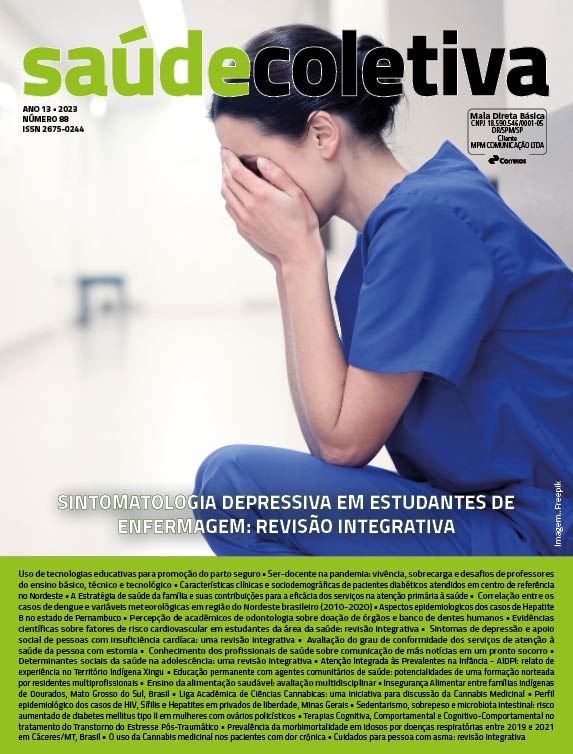Perception of dentistry students about organ donation and human teeth bank
DOI:
https://doi.org/10.36489/saudecoletiva.2023v13i88p13207-13216Keywords:
Tooth; Teaching; Bioethics; Legislation; Bank of Human TeethAbstract
Objective: Identify, through a questionnaire applied to undergraduate Dentistry students at a university in the City of São Paulo, the origin of teeth obtained for use in preclinical training. Method: This is an exploratory and descriptive study, of a qualitative and quantitative nature, carried out from August to December 2018, the sample consisted of 2404 respondents, the research was submitted to the Ethics and Research Committee, according to the Resolution 510/16. Results: Only 40% know the legal value of the extracted tooth as an organ, about 46% of the students obtained teeth by purchase and the rest obtained them free of charge at dental clinics or veterancolleagues. Conclusion: Through the results, it is concluded that there is a need to publicize the activities of human teeth banks not only in academia, but for the entire population in order to raise awareness of the academic community and curb illegal trade.
References
. Imparato JCP, et al. Banco de dentes humano: uso em pesquisa e ensino odontológico. In: RAMOS, Dalton Luiz de Paula (Editor). Bioética & ética profissional: fundamentos de odontologia. Rio de Janeiro: Guanabara, 2007. Cap. 8, p. 80-86.
Medeiros MC dos S, Costa I do CC, Silva EM da, Sales FCCF. Aspectos ético-legais que envolvem a manipulação de dentes humanos extraídos: o olhar de cirurgiões-dentistas. Rev ABENO. 2021;21(1):1241.
Vanzelli M; Imparato JCP. História e introdução. In: IMPARATO, José Carlos Pettorossi. Banco de dentes humanos. Curitiba: Maio, 2003. Cap. 1, p. 23-30.
Dominici, JT; Eleazer, PD.; Clark, SJ; Staat, RH; Scheetz, JP. Disinfection/sterilization of extractet teeth for dental student use. J Dent Educ, San Francisco, v. 65, n. 11, p. 1278-1280, Nov. 2001.
Dewald, JP. The use of extracted teeth for in vitro bonding studies: a review of infection control considerations. Dent Mater, Copenhagen, v. 13, n. 2, p. 74-81, Mar. 1997.
Paula, S; Bittencourt, LP; Pimentel, E; Gabrieli Filho, PA; Imparato, JCP. Comercialização de dentes nas universidades. Pesqui Bras Odontoped Clín Integr. 2001;1(3):38-41.
Brasil, SA; Ana, PA; Botta, SB; Franchim, GH; Imparato, JCP. Uso de dentes humanos no ensino laboratorial, meios de aquisição e desinfecção pelos alunos de graduação da Fousp-SP. 19a Reunião da Sociedade Brasileira de Pesquisa Odontológica; 2002. Pesqui Odontol Bras. 2002;16(suppl):31.
Costa, SM; Mameluque, S; Brandão, EL; Melo, AEMA; Pires, CPAB; Rezende, EJC et al. Dentes humanos no ensino odontológico: procedência, utilização, descontaminação, e armazenamento pelos acadêmicos da Unimontes. Revista da Abeno. 2007;7(1):7-12.
Pinto, SL; Silva, SP; Barros, LM; Tavares, EP; Silva, JBOR; Freitas, ABDA. Common, Academic and Professional Knowledge of Human Tooth Bank. Pesq Bras Odontoped Clin Integr 2009; 9(1):101-6.
Brasil. Lei n. 9.434, de fevereiro de 1997a. Dispõe sobre a remoção de órgãos, tecidos e partes do corpo humano para fins de transplante, e dá outras providências. Diário Oficial da União. Brasília, 5 fev. 1997; seção 1, p. 2191-3.
Lei Nº 9.434, De 4 de fevereiro de 1997. Disponível em: http://www.planalto.gov.br/ccivil_03/leis/l9434.htm. Acesso em 06/08/2011
Brasil. Código Penal e Constituição Federal. 47. ed. São Paulo: Saraiva, 2009
Decreto lei 4657, de 04/09/1942 – Lei de Introdução ao Código Civil (LICC). Diário Oficial da União. Rio de Janeiro, 09/09/1942
Fonseca, DD de; Abreu, LO de; Silva, YS; Vieira, AH; Cardoso, CS; Braga, IM; Rolim, AKA; Maciel, PP; Oliveira, MAC de; Drumond, CL. Knowledge about ethical issues in the use of human teeth among undergraduate dentistry students and dentists. Research, Society and Development. 2021;10(16):e427101323894.







